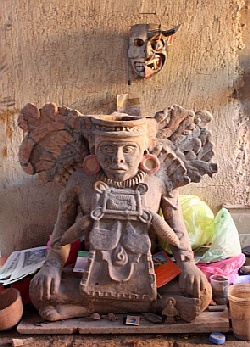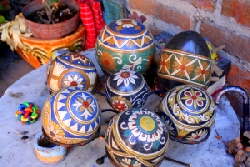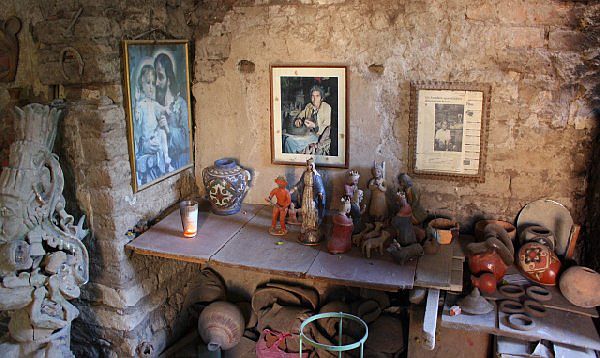San Juan Evangelista, Mexico - I first met maestro Martín Ibarra Morales last November when – as one of the artisans invited to Ajijic’s annual Feria Maestros del Arte – he and his family were my houseguests.
Martín is a clay sculptor whose work is collected worldwide. His renowned artisan father taught him his craft, and he’s most well-known for his intricately formed and painted virgins and globes.
 |
He lives on the shore of Lake Chapala’s smaller cousin, Lake Cajititlan, in the village of San Juan Evangelista which is – as the crow flies – not 15 kilometers from Ajijic. The driveable route around the mountain is about twice the distance.
Traveling with me is friend and Ajijic artist Jesús López Vega, who has an abiding interest in native artisans and is a welcome bridge over the gaps in my Spanish. Our directions fail us just a few blocks short of our destination, but we park along the principal plaza opposite the church and graveyard and strangers direct us to a home walled in adobe brick; Martín is clearly also a local celebrity.
A small foyer opens into an open air patio, its brick walls adorned with framed news clippings and certificates of recognition, and tables covered with some of the maestro’s work. We turn the corner into the studio, a Spartan room in brick and stucco.
On a table at its center sits one of Martín’s celebrated virgins, which looks to my untrained eye nearly finished. Works in almost every stage of completion seem to take up every square inch of the room, ranging in size from clay whistles that rest easily in the palm to Aztec statuary nearly as tall as Martín’s diminutive frame.
Martín is soft-spoken, but not shy, and as he warms to the conversation he talks animatedly, punctuating remarks with his hands. Often he’ll move the conversation to a quickly sketched explanation of his point.
 |
He and my artist friend Jesús quickly plunge into rapid-fire Spanish, comparing notes from old texts of art history that trace the origins of their work back to pre-Hispanic traditions. Their Spanish soon races past me and I wander the studio as they talk.
A statue looking for all the world like a recently excavated museum piece stares at me impassively. A devilish mask simultaneously smiles and leers at me from the wall behind it. In one corner finished work sits on a mantel above a brick kiln, its face smoked black by decades of use.
Just as it seems that the visit is about to draw to a close, Martín points through the gate past the cemetery to the church beyond, and asks if we would like him to take us on a tour. It’s a hospitality not to be refused, and we walk into the bright sunlight and across the street. What he shows us there turns out to be as memorable an experience as the opportunity to see his workspace, and it’s the topic of my next post, so stay tuned...


